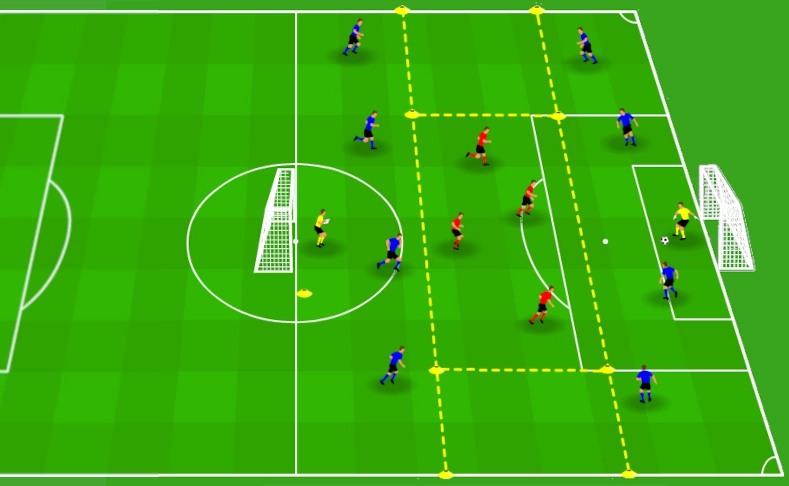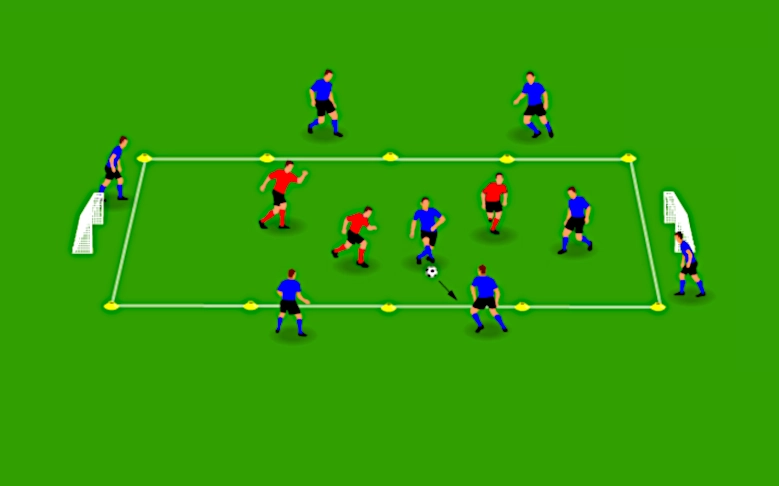Passing and Control Circuit: Boost Skills and Teamwork
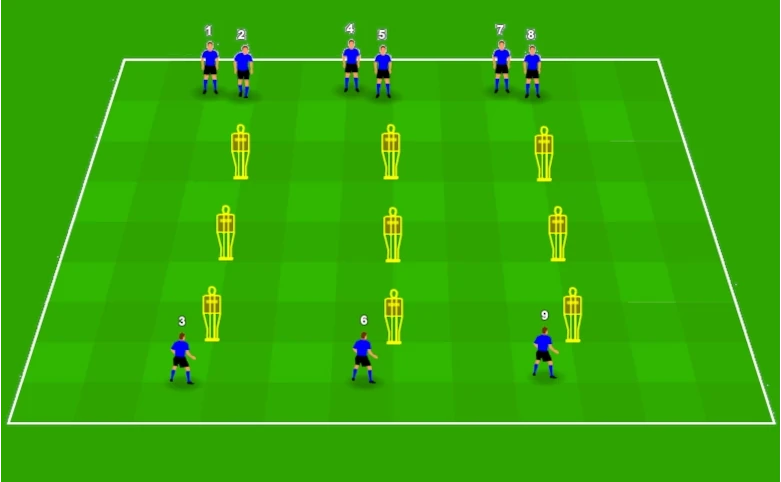
Improving passing accuracy, ball control, and player movement is essential for building a cohesive team. This passing and control circuit is a structured exercise that enhances players’ technical skills and awareness on the field. The exercise incorporates mannequins and player rotations to simulate match scenarios, ensuring players develop sharp decision-making and fluid gameplay. This drill is ideal for intermediate to advanced players but can be adapted for beginners by adjusting the pace and complexity.
Setup
To set up this passing and control circuit, you will need the following:
-
Space: Divide the field into 3 vertical zones with 3 mannequins staggered in each of them. See the picture below.
-
Equipment: 9 mannequins or cones and a football.
-
Players: A minimum of 9 players are needed to provide a continuous flow and intensity.
-
2 players per zone start on one size.
-
1 player per zone waits on the other side
-
The mannequins act as obstacles that players must navigate using quick passes and precise movement.

Instructions
The steps described in each zone happen simultaneously, creating a continuous circuit. Use the pictures below as a reference, following the steps from top to bottom and left to right of the picture. We also share a video of a similar exercise to help understand each phase.
Zone 1:
-
Player 1 begins by running with the ball toward the last mannequin in Zone 1.
-
Player 1 passes the ball between the 2nd and 3rd mannequins to Player 3 (waiting on the opposite side of the zone).
-
Player 3 receives the ball and runs toward the first mannequin in the zone.
-
Player 3 passes the ball between the 1st and 2nd mannequins to Player 2 (waiting at the starting position of the zone).
-
Player 3 runs to the beginning of Zone 2 (middle row of mannequins).
-
Players 1 and 2 repeat the previous steps.
Zone 2
-
Player 4 starts by running with the ball toward the last mannequin in Zone 2.
-
Player 4 runs diagonally between the 2nd and 3rd mannequins toward Player 6 (waiting on the opposite side).
-
Player 4 passes the ball to Player 6 immediately after running through the mannequins.
-
Player 6 receives the ball and runs toward the first mannequin in the zone.
-
Player 6 runs diagonally between the 1st and 2nd mannequins toward Player 5 (waiting at the beginning of the zone).
-
Player 6 passes the ball to Player 5 immediately after running through the mannequins.
-
Player 6 runs to the beginning of Zone 3 (right-hand row of mannequins).
-
Players 4 and 5 repeat the previous steps.
Zone 3
-
Player 7 starts by kicking a long pass to Player 9 on the other side of Zone 3.
-
Player 7 runs toward the end of the zone.
-
Player 9 receives the ball and shifts to the right side of the mannequins.
-
Player 9 kicks a long pass to Player 8 (waiting at the starting position).
-
Player 9 runs to the beginning of the zone and continues running to the starting position in Zone 1 to restart the circuit.
-
Players 7 and 8 repeat the previous steps.
Players rotate positions after completing each sequence to ensure equal participation and adaptability. Repeat the circuit at least five times at pace.
The first time this exercise is executed, players may collide or disrupt the flow. Start at a slower pace, focusing on coordination and accuracy. Gradually increase the speed as players become more comfortable.
Encourage players to communicate by calling for the ball and maintaining a steady rhythm.
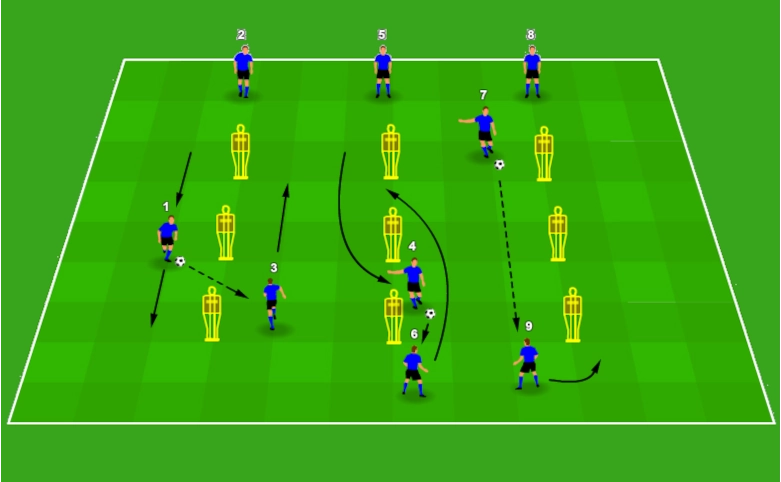
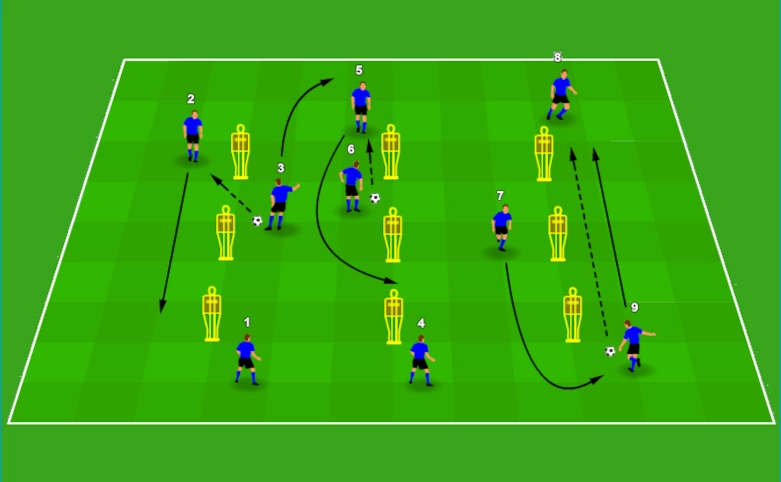
Takeaways
Incorporating this passing and control circuit into regular training sessions will help players develop technical skills, game intelligence, and coordination. Additional benefits include:
-
Passing Precision: Players refine their ability to deliver accurate passes under pressure.
-
Long balls: Consistency is critical in long balls. They must be timely and have the right power to make them easy for a teammate to control.
-
First touch: Players must improve their first touch to quickly control and pass the ball.
-
Ball control at speed: Players develop the skill to sprint at high speeds without sacrificing ball control, which is essential for breaking away from defenders.
-
Speed and reaction: Once players pass the ball, they must sprint to the next station and be ready to receive the ball. This requires quick reaction and speed.
-
Positioning Awareness: Movement around mannequins helps players understand spatial dynamics.
-
Team Coordination: Rotations foster communication and chemistry among teammates.
We’d love to hear how this drill benefits your team. Please share your experiences and modifications on our Facebook page or tag us in your training videos.

